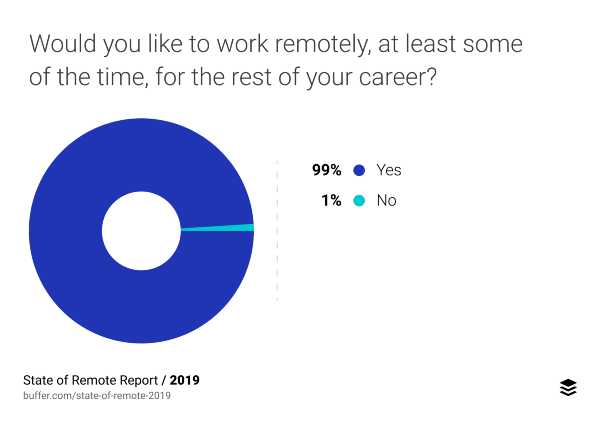5 Ways to boost Employee experience within a firm
Around a decade ago, companies used to break important news to employees through e-mail announcements, boring newsletters and or over redundant intranet. Well, those days have passed. Employees and workplaces have rapidly changed over the last five years, and modern employees no longer serve the company as ignored stakeholders. Now there are clear and measurable expectations of what makes a good employee experience at a workplace.
“When you treat employees like they make a difference, they will,” says American billionaire Jim Goodnight, the CEO of SAS Institute. What he says resonates with most firms today. The real meaning of EX lies in understanding what makes your employees happy, especially in the present times of deskless jobs and remote work locations. Look at this image below-

99% of the 2500 remote workers surveyed by Buffer said that they’d like to work remotely for the rest of their career. Remote working is not a trend of the pandemic, it is here to stay! Around 30% of the companies across the world said that their employees work from home. With such geographical dispersion, engaging and communicating with employees, managing work, while also ensuring that employees aren’t disconnected or feel left out from key decision making, becomes challenging for modern firms.
From rewarding, engaging them, being empathetic, contributing towards their knowledge management, focusing on their holistic development, to their personal wellbeing, addressing mental health and overall health, here are five ways in which organizations can enhance Employee experience:
- Change the whole employee experience narrative by working on strong internal communication
Effective internal communication strategy is essential for excellent employee experience. While most CEOs and CMOs remain focused on how well their company interacts with external stakeholders like customers and media, they tend to overlook the importance of internal communication with employees. 63% of the employees do not trust their leaders at all. That’s a whopping number, and unsurprisingly this lack of trust comes from improper or poor internal communication. Modern employees want to be delivered the right information through the right channels and at the right time.
- Listen to your employees; act on it
Listening to the employees through feedback is one thing, and acting on it is a whole another thing. Most firms tend to overlook the importance of empathy and how well the employees are/aren’t treated at the times of crisis or during their life’s personal milestones. Feedback from employees within a firm is a testing bed for any firm. It becomes a company’s responsibility to ensure that the changes within a workplace are implemented on the basis of feedback. Successful companies designate the responsibility of action plan to personnel and ensure that employees’ feedback is paid heed to.
- Focus on the role of managers in great employee experience
The top leaders and managers of a firm are often occupied with establishing external rapo, so much so that they forget that real investment in their business begins at the workplace. What do you think an employee needs from its manager? A surprise weekday off? Well, as much as a considerate manager offering such surprises does bring short-term happiness, its ultimately these three things that define the role of a manager in great EX-
a) Opportunity for an employee to grow and develop
b) Recognizing and appreciating employees’ work and effort
c) Offering one-on-one feedback and authentic communication to foster employees’ career growth.
- Make them antifragile, not resilient
Antifragility helps employees to benefit and grow from errors or volatility. Antifragility can go a long way in holistic employee development if the intent of the leadership team is employees’ personal success too. Companies can offer career development by putting such training programs in place which can build leaders out of regular employees. Having discussions with employees regarding their long-term career plans and assigning an individual mentor to help them achieve their goals will help employees stay at the same workplace, while also widening a company’s internal talent pool.
- Employee Wellness Initiatives
An aggregate report by Health Advocate suggests that stress can have a profound negative impact over employees’ productivity, which in numbers, results in $300 billion each year. By fostering the work culture where employees are taken care of, firms tend to generate quadruple times more revenue than those organizations which lack sensitivity towards employees’ health. Implementing sick time, paid vacations as rewards, on-site gyms, online fitness and yoga sessions, nutrition workshops, and providing weekend-friendly healthy snacks to employees are a few ideas to consider. That being said, a firm has a mix of all age groups of people. Companies must come up with sessions which ensure all-employees-inclusivity.
To fashion great employee experience, an organization must understand its fabric. What matters most to your people? If you’ve an answer to that, you also have an answer to what formula would work best for your organization. Remember, what goes inside a firm, reflects outside to the world!




